Every year, the Festival of Fire (Chaharshanbe Suri) is held on the final Wednesday (marks the arrival of spring). For the new year, health and happiness were wished by fire and light. This holiday (Persian Calendar), which dates back to at least 1700 BCE, is celebrated in Iran, Azerbaijan, Iraq, Afghanistan, Tajikistan, and Turkey. Iranians commemorate “Chahar Shanbeh Suri,” a long-standing custom.
The celebration begins with the lighting of the fire, after which bushes and firewood are stacked in the streets and on roofs. where people of all ages congregate and jump over fires that burn all night. These bonfires stand for generosity, camaraderie, and light.
The History of Chaharshanbe Suri
Contrary to popular belief, Charshanbe Soori is not strictly a Zoroastrian holiday. Since the Arab invasion, the manner people celebrate it now has undergone significant change. Because they are the four primary components of nature, water, and fire, Zoroastrians, who were the Iranians’ first religious leaders, consider soil, and air sacred. Fire is one of these four that has the most blessings since it is cleansing and never becomes contaminated. Zoroastrians had great regard for fire; hence they would never intentionally start a fire in the street and leap over it.
The Epic of the Kings, often known as the Shahnameh, is an important source for the history of the Chaharshanbe Suri celebration. King Keikavoos’s queen Sudabeh is said to have fallen in love with the king’s son Siavash.
Siavash rejects Sudabeh‘s attempt to trick him, despite her best efforts. The king invites Siavash to explain when he learns what is happening between the stepmother and the son. Siavash informs King Keikavoos, his father, that he is prepared to cross the flames to demonstrate his innocence. He had great regard for fire and thought that it would not hurt an innocent person.
On the final Tuesday of the Iranian year, he prepares to cross the fire and emerges unharmed from its flames. In accordance with the king’s directive, a huge celebration was held the next day, on the final Wednesday of the year, and it was known as “Chahrshanbe Suri,” which is Persian for Wednesday celebration.
Since then, Iranians have been commemorating this wonderful day by moving about and jumping over large flames, singing, dancing and enjoying Shahnameh poets on the final Tuesday of the year.
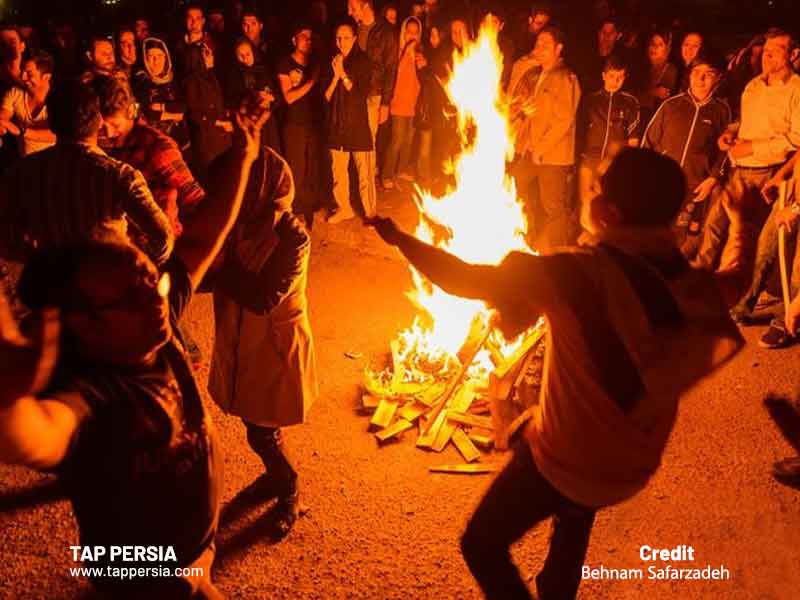
Chaharshanbe Suri During Qajar Empire
It used to be common in Tehran to request assistance from the so-called “Pearl Cannon” (Tup-e Morvrid) on Chaharshanbe Suri.
During the rule of Fath-Ali Shah of the Qajar dynasty in 1800, the foundryman Ismail Isfehani created this large cannon, which was the subject of several urban legends. It was located in Arg Square, where Tehran residents used to congregate during Chaharshanbe Suri, until the 1920s.
Mothers also forced misbehaving and bothersome children to pass under the barrel in the hope that doing so would make them behave better. Individuals with impairments and unmarried women who are childless or unhappy spouses frequently sit on the barrel or crawl underneath it.
As soon as the Pearl Cannon was relocated to the Army’s Officers’ Club in the 1920s, these traditions were abolished. In Tabriz, there existed a second Pearl Cannon.
Girls and women would fasten their dakhils, which are pieces of paper or fabric that have wishes and prayers imprinted on them, to the barrel on the occasion of Chaharshanbe Suri. The cannon has occasionally served as a haven for political and non-political fugitives seeking protection from family issues or an escape from capture.
Tup-e Morvrid is the title of a book by Iranian prose fiction and short story author Sadegh Hedayat that critiques traditional Iranian folklore. Pearl Cannon’s history is also mentioned in the book.
The Pearl Cannon is now displayed in the lobby of the Ministry of Foreign Affairs Building Number 7 at 30th Tir Avenue, although the Cultural Heritage Organization of Iran continues to argue with the ministry over moving the cannon to a museum.
What day is Chaharshanbe Suri 2023?
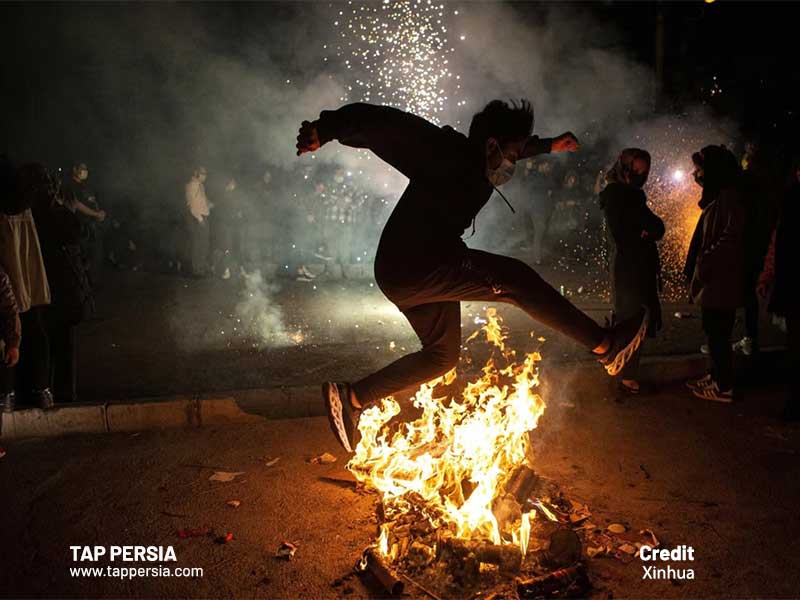
The Iranian calendar serves as the foundation for the Persian calendar, which runs from sunset on the final Tuesday of each Iranian year to midnight. As a result, each year’s Charshanbeh Soori festival falls on a different day. The Chaharshanbe Suri for this year is scheduled for Tuesday, March 14, 2023.
On Chaharshanbe Suri, What Do Iranians Do?
On this night, several customs are observed in various Iranian towns. Some of the most well-liked and popular ones are listed below:
Jumping Over Fire
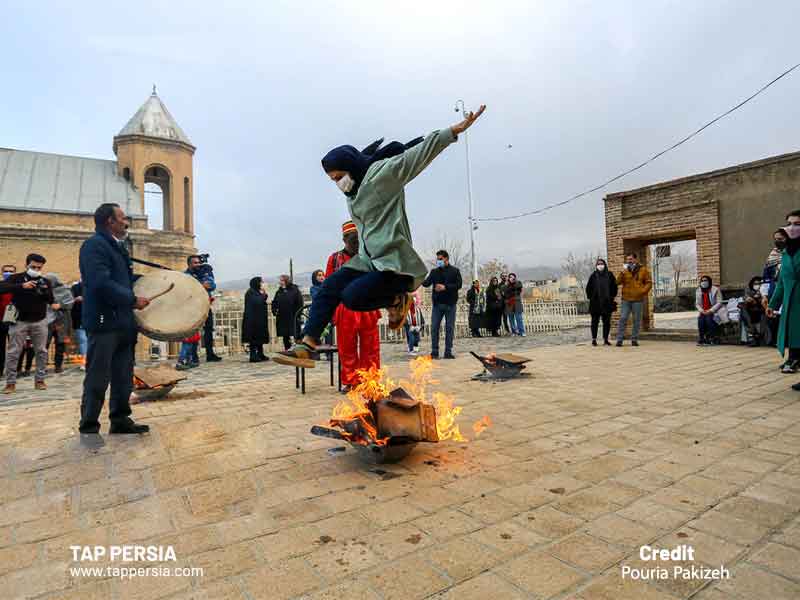
Lighting a fire, jumping over it, and spending the night by the fire is the most significant Chaharshanbeh Suri rite that is still practiced today. People gather dry bushes and twigs for this ceremony, lighting both huge and tiny flames in the streets, alleyways, and even on the tops of buildings.
Then, the entire family jumps over the fire while chanting, “My yellow is yours, your red is mine,” in accordance with the Charshanbeh Soori. In this expression, which is a kind of prayer, we beg the fire to bestow upon us its warmth and freshness rather than burning our illnesses, difficulties, and sufferings. After that, everyone gathers around the fire to eat, sing, and dance.
On Chaharshanbe Suri evening, people ignite fires in the mountains of Iran’s Kurdish towns. Around the fire, everyone holds hands with each other while singing hymns and doing Kurdish dancing. Notably, fireworks materials like firecrackers and squibs generate diverse effects in the streets nowadays rather than simply making a fire and leaping over it. There are colored flames and spark waterfalls everywhere.
Qaashoq-Zani, the Iranian Trick or Treat
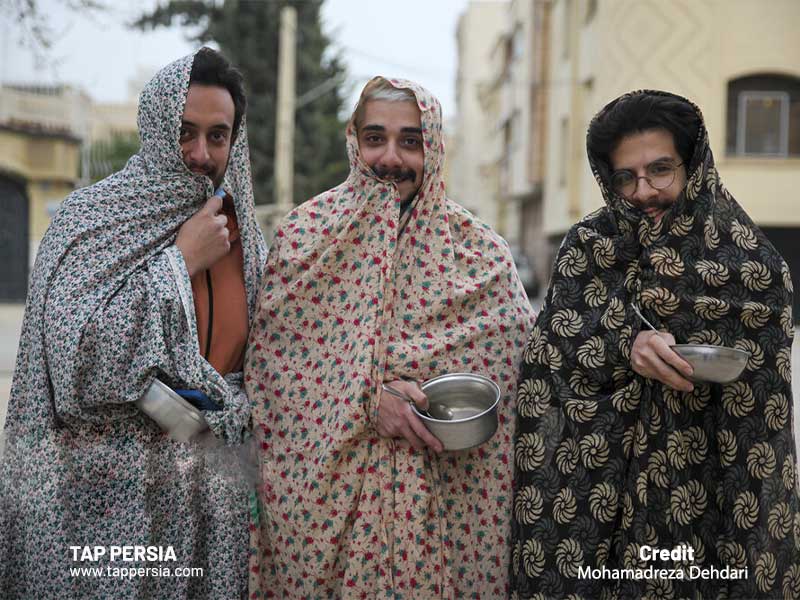
The Qaashogh-Zani, also known as “spoon-hitting,” is one of the most intriguing Charshanbe soori rituals that are still performed in various Iranian cities, including Ahvaz. It is similar to Halloween’s trick-or-treating but older. In this rite, young girls and boys grab a spoon and a bowl while covering their heads with veils.
After that, they visit the neighbors’ homes and smack spoons into bowls. When the landlord hears the sound of a spoon being hit, he rushes to the door and stuffs their bowls with candy, nuts, or money. This custom states that individuals who steal anything from the landlord are favored and wealthy.
The tradition of slamming a spoon on a table stems from the notion that, at the end of the year, the souls of the deceased come to their homes while hiding their faces to ask for favors. They communicate by using spoon-hitting since they are unable to talk.
Kuze-Shekani (Earthenware Jug-Shattering)
Shattering an earthenware jug was another unique Chaharshanbe Suri ceremonial that was primarily carried out in the past. In an ancient earthenware jug, the Iranians perform this ceremony by adding salt (to ward off the evil eye), charcoal (to represent illness), and a cheap coin (to represent poverty).
The last family member then tosses the jug from the roof to the alley after turning it around in his hands. By performing this ceremony, people thought they might banish suffering, squalor, and unhappiness from their houses.
Shaal-Andazi (Shawl-Dropping)
Another Chaharshanbeh Suri tradition is called shal-andazi, and it is observed in various Iranian villages as well as in Hamedan and Zanjan. In this custom, young people braid long multicolored ropes out of colorful scarves. They then send it into the neighbor’s home through the chimney and draw the landlord’s attention with a few raucous coughs.
The landlord ties the Charshanbe Soori present in the vibrant shawl as soon as he sees it. The guy on the roof does this by drawing the shawl. Every gift has a meaning; bread represents blessings, pastries represent happiness, and pomegranates represent fertility.
Chaharshanbe Suri Food
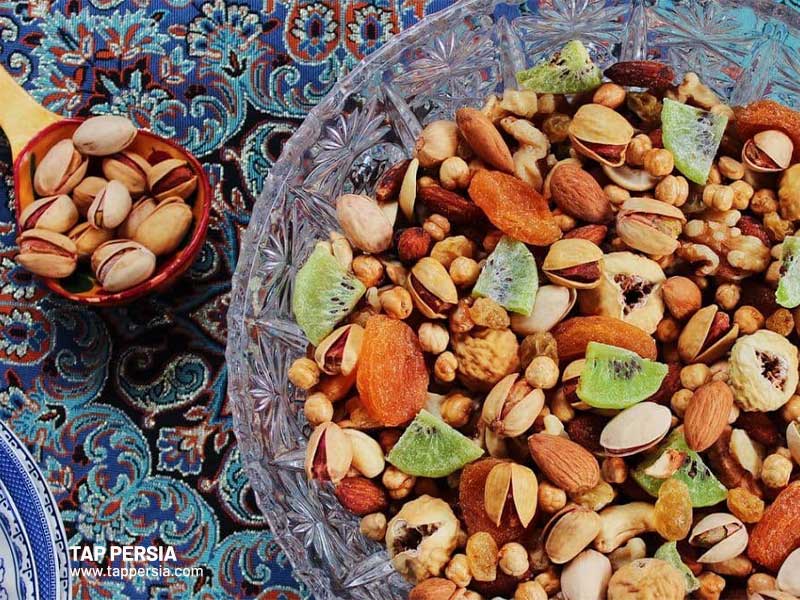
Family members consume various nuts (known as Ajile Chahar Shanbeh Suri) and fruits as they gather around the fire for the Chaharshanbe Suri night meal. In addition, unique cuisine is made in several regions of Iran for the Chaharshanbe Suri celebration.
For instance, individuals in various regions of Iran produce Ash Reshteh (Persian noodle soup) or a particular type of regional soup; others cook a meal called Ash-e Abu Darda. Actually, people prepare this soup if they have a sick person at home and hope the new year will bring him healing.
Of fact, on Charshanbe Soori night, the ancient Iranians prepared a dish called “Polo Haft Rang,” a pilaf. So they made seven various types of colorful pilafs, including ones with dill, cumin, raisins, dates, lentils, and other ingredients.
Experience Chaharshanbe Suri by Traveling to Iran
So why do you still have to wait? The Chaharshanbe Suri festival is a great time to visit Iran! The Nowruz festivities will most likely fall within the time of your vacation. During these holidays, you’ll encounter lots of joyful Iranians. But making hotel reservations in Iran’s tourist destinations is not particularly simple.
What is Suri in Persian?
The Persian word Suri refers to a kind of red rose as a noun and the color “red” as an adjective. In Persian, the word “Suri” is frequently used to denote a carnival or other happy gathering.
Who Celebrates Chahar Shanbeh Soori?
Persians in Iran, Tajikistan, and Afghanistan typically observe this beautiful old holiday, but it has also been seen that individuals from Azerbaijan, Iraq, and Turkey participate in this celebration.



Thanks for the excellent manual
I like the report
I like the article